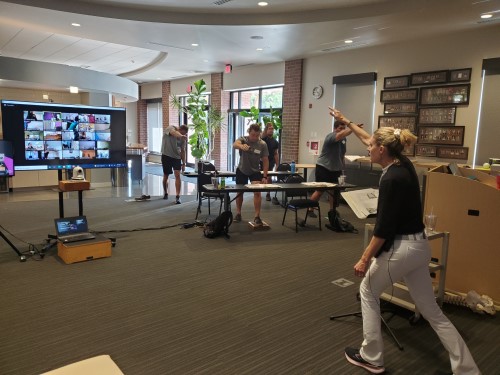After a nearly 18-month hiatus, it was a thrill to present Postural Respiration to my fellow clinicians in the very place the science originated. The combination of live and zoom attendees — PTs, PTAs, ATCs, Massage Therapists, Chiropractors, Students, Strength and Conditioning Specialists, a Pilates Instructor, and a Kinesiologist — hailed from the US, Canada, Germany, and Ireland.
The weekend was devoted to the asymmetrical, patterned thoracic diaphragm and its influence on the autonomic nervous system, patterned movement, and the brain’s sense of itself in space. We learned that our asymmetrical body is a necessary design for survival and is kept “in check” when we engage in varied activities throughout our lives. However, most of our patients-clients fail to do so, which kick starts pain, pathology, and injury.

As the Olympics come to their conclusion, it seems apt to compare PRI’s treatment approach to a track relay:
Leading off and exploding out of the blocks are the abdominals (internal obliques and transverse abdominus), which enable full lung expulsion of air and establish the (left hemi-) diaphragm ZOA.
The second leg, the diaphragm itself, now pulls air in with an adequate ZOA and hands off the baton to the third leg…
…the rib cage, whose external rotation and internal rotation properties are restored, particularly in the left posterior mediastinum and right apical and lateral chest wall regions.
Finally, our anchor leg, the lungs, bring the baton home. They now have the space to expand into and out of regions that were previously closed off, for the health of the many vital vessels that travel in, around, and through the thorax. Moreover, the restoration of alternating, reciprocal lung compression-expansion produces alternating, reciprocal movement, both simple and complex.

Ample lab time was devoted to assessment of the patterned body so that each attendee had confidence come Monday morning with replicating the tests on their patient-client. Instruction in manual rib cage techniques was also heavily emphasized, so that attendees had both observational and tactile sense of patterned air flow. Finally, many non-manual techniques were discussed and performed, including when and why you choose them and how to coach your patient-client through them.


Thank you to all of those who asked questions. You enhanced the course experience for all. Thank you to our avatars Brett Dougherty, PT, Matt Mandich, SCCC, CSCCA, Joshua Werk, ATC, CSCS, and Tammi Zimmerman, LMT for allowing us to bring the tests and techniques to life.
Thank you to Justin Pastoor, MS, CSCS, for your clear verbal instruction while tests and techniques were demonstrated.
I now fully understand what Ron means when he says he couldn’t have presented the material with the same easy flow and energy without the assistance of Jen Platt. Thank you for ensuring there were no technology glitches, deftly navigating the camera angles, monitoring questions, and keeping this instructor and live attendees well-hydrated and fed.
Looking forward to seeing many of you again as you continue your PRI journey!


